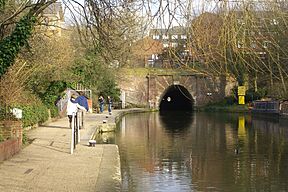Regent's Canal facts for kids
Quick facts for kids Regents Canal |
|
|---|---|

West portal of the Islington tunnel
|
|
| Specifications | |
| Length | 8.6 miles (13.8 km) |
| Maximum boat length | 78 ft 0 in (23.77 m) |
| Maximum boat beam | 14 ft 6 in (4.42 m) |
| Locks | 13 |
| Status | Open |
| Navigation authority | Canal and River Trust |
| History | |
| Principal engineer | James Morgan |
| Date of act | 1812 |
| Construction began | 14 October 1812 |
| Date of first use | 1816 |
| Date completed | 1 Aug 1820 |
| Geography | |
| Start point | Paddington Arm (Grand Union Canal) |
| End point | River Thames (Limehouse) |
| Branch(es) | Hertford Union Canal Limehouse Cut |
The Regent's Canal is a famous waterway in England. It flows through the city of London. This canal is an important part of London's network of canals. It connects the Grand Union Canal to the River Thames.
Contents
Building the Canal
The idea for the Regent's Canal came about in the early 1800s. People wanted a way to move goods easily across London. Roads were often muddy and slow. Waterways were a much better option for heavy items.
When it was Built
The plan for the canal was approved in 1812. Building work started on October 14, 1812. It took many years to finish this big project. The canal was finally opened on August 1, 1820.
Who Built It
The main engineer for the Regent's Canal was a man named James Morgan. He designed the route and the structures needed. Building a canal involved a lot of digging and construction. Workers had to build locks and tunnels.
How the Canal Works
The Regent's Canal is about 8.6 miles (13.8 kilometers) long. It has 13 locks along its path. Locks are like water elevators for boats. They help boats move up or down between different water levels.
Key Features
- Islington Tunnel: This is a long tunnel that boats travel through. It's one of the longest canal tunnels in London.
- Limehouse Basin: This is where the canal meets the River Thames. It's a large area where boats can dock.
- Paddington Arm: The canal starts by connecting to the Paddington Arm. This arm is part of the Grand Union Canal.
Life on the Canal
For many years, the Regent's Canal was very busy. Boats called barges carried coal, timber, and other goods. They helped London's businesses grow.
The Canal Today
Today, the canal is not used much for carrying goods. Instead, it's a popular place for fun activities.
- Boating: Many people live on houseboats along the canal. You can also take boat trips.
- Walking and Cycling: There are paths along the canal banks. These are great for walks or bike rides.
- Wildlife: You can often see ducks, swans, and other birds. Sometimes, you might even spot fish in the water.
The Regent's Canal is now managed by the Canal and River Trust. They work to keep the canal clean and safe for everyone to enjoy. It's a peaceful green space in the busy city.
Images for kids
See also
 In Spanish: Regent's Canal para niños
In Spanish: Regent's Canal para niños





